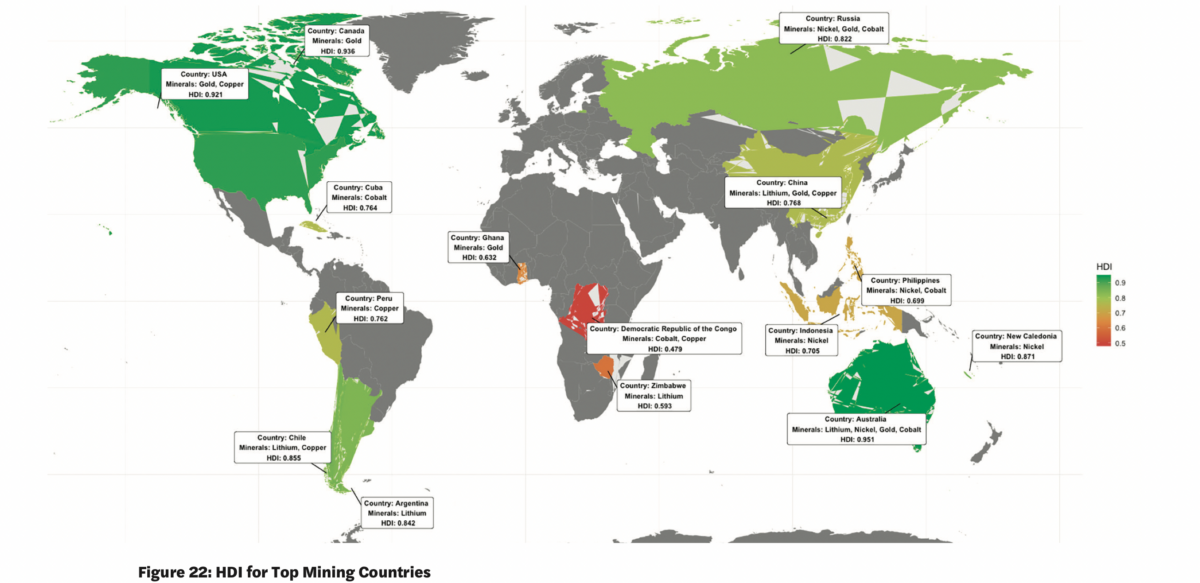The Payne Institute for Public Policy at Colorado School of Mines released The State of Critical Minerals Report 2023. The analysis examines how the increasing demand for the critical minerals necessary to power a green economy will impact global communities, markets, national security, and geopolitics.
Multi-disciplinary experts from the Colorado School of Mines worked together to assess the social economic and policy implications of the race to secure an ethical and reliable domestic supply chain.
The United States Geological Survey suggests that lithium, nickel, cobalt, manganese, and graphite are the metals needed to power electric vehicles. Alternatively, arsenic, gallium, germanium, indium, and tellurium are essential to constructing solar panels.
Many of these minerals, however, are mined and processed in foreign adversary’s. Australia produces over 40% of lithium, with Chile following close behind. Over 50% of the world’s cobalt and nickel production happens in the Democratic Republic of Congo and Indonesia. China leads the world’s Rare Earth Elements (REE) production – materials primarily used to build solar panels – it also produces the world’s graphite. South Africa accounts for more than half of the world’s Platinum Group Metals (PGMs) production, also used to construct solar panels.
Regarding downstream processing, China leads the global mineral value chain. It processes and refines 100% of the world’s natural graphite 80% of the world’s manganese and 70% of worldwide cobalt and lithium. Moreover, the country controls 80% of the world’s lithium-ion battery production, 77% of the world’s battery cell capacity and 60% of the world’s battery component manufacturing.
The report states that domestic mining capabilities must increase exponentially to establish a reliable domestic supply chain. Projections indicate that by 2030, the demand for lithium could triple. EV and battery storage technologies have surpassed consumer electronics in becoming the most significant users of lithium. The report states they will exceed stainless steel to become the primary end users of nickel by 2040.
This leaves many environmental and social implications to consider. The report suggests reimagining a domestic mining sector that produces some of the raw materials needed for clean energy infrastructure under scrutiny, “The sector should be subject to the most protective standards in the world and above all – with strong public support,” said Morgan Bazilian, Director of the Payne Institute for Public Policy.
The report suggests coupling the recycling of critical materials and sustainable mining practices to reduce the land degradation air pollution and water contamination that results from extraction. According to the Massachusetts Institute of Technology, extracting one ton of REEs produces about 2,000 tons of toxic waste and greenhouse gasses like sulfur hexafluoride. This scenario’s global warming potential is 23,900 times more than carbon dioxide. The report suggests investing in carbon capture and storage to lessen the carbon footprint of mining operations.
Permitting reforms like re-assessing the General Mining Law of 1872 to establish a clear direction for allowing hard rock mines are recommended. The report also asks that stakeholders continue to invest in education programs that can help generate the necessary human expertise to develop socially economically and environmentally conscious domestic mining practices.
According to the report, research is ongoing on whether we can safely and ethically mine asteroids and the deep sea bed of international waters. This is because minerals including iron, nickel, iridium, palladium, platinum, gold and magnesium have been found in asteroids. Moreover, researchers have spotted two metal-rich asteroids near the earth with 85% iron nickel and cobalt, which exceed global reserves.
Along with needing the right technology, there are dangerous ramifications from altering celestial bodies and creating space debris. Moreover, research shows deep-sea mining could severely harm marine biodiversity and ecosystems, the report states. Even so, the International Seabed Authority has issued 31 contracts to explore deep-sea mineral deposits, and mining in international waters could start as early as 2026.
The report was released after a two-day Critical Minerals Symposium hosted by Payne Institute last week. The report and symposium are part of a broader effort by the Colorado School of Mines to connect the technical and scientific expertise of the university with global conversations related to energy issues.
This content is protected by copyright and may not be reused. If you want to cooperate with us and would like to reuse some of our content, please contact: editors@pv-magazine.com.








By submitting this form you agree to pv magazine using your data for the purposes of publishing your comment.
Your personal data will only be disclosed or otherwise transmitted to third parties for the purposes of spam filtering or if this is necessary for technical maintenance of the website. Any other transfer to third parties will not take place unless this is justified on the basis of applicable data protection regulations or if pv magazine is legally obliged to do so.
You may revoke this consent at any time with effect for the future, in which case your personal data will be deleted immediately. Otherwise, your data will be deleted if pv magazine has processed your request or the purpose of data storage is fulfilled.
Further information on data privacy can be found in our Data Protection Policy.